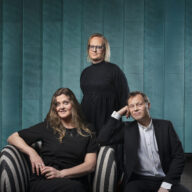Falleg og skemmtileg fjölskylduskemmtun með áherslu á börn á aldrinum 4 til 9 ára. Aðgangur er ókeypis og öll hjartanlega velkomin á meðan húsrúm leyfir.
Trúðavinkonurnar Silly Suzy og Momo eru jólabörn og hlakka ægilega mikið til hátíðarinnar. Silly Suzy hefur aldrei dvalið á Íslandi áður (hún er frá Clown Town í Bandaríkjunum) svo Momo vinkona hennar kennir henni hvernig skemmtilegast er að njóta saman aðventunnar á Íslandi.
Þær vinkonur bregða sér saman á skautasvell og búa til snjókall, skreyta allt hátt og lágt og baka piparkökur. Allt með hæfilegri blöndu af trúðalátum og prakkarastrikum, loftfimleikum og alveg geggjuðum jólalögum sem koma okkur öllum í sannkallað jólaskap.
Sýningin er á íslensku og ensku og stendur yfir í um hálftíma.
Fjölskyldustundir á laugardögum eru styrktar af lista- og menningarráði Kópavogsbæjar.
Free Christmas show for kids of all ages.
The clown friends Silly Suzy and Momo are really looking forward to the holidays.
Silly Suzy has never stayed in Iceland before during Christmas – she’s from Clown Town in the USA – so her friend Momo teaches her how to enjoy the advent in Iceland. They bake, go ice-skating, decorate the hall etc. – all with a suitable mix of clowning and pranks, acrobatics and wonderful Christmas songs that will get us all in the true Christmas spirit.
The show is in Icelandic and English and lasts about half an hour.
Great family entertainment with a focus on children. aged 4 to 9 years.
Admission is free and everyone is welcome while space allows.
——————-
About Lauren Charnow:
Lauren Charnow is a born performer who grew up singing and dancing in her parent’s theater company in the United States.
Lauren has studied circus arts and dance in New York City taking classes at Broadway Dance Center, Circus Warehouse, and Steps.
After attending Marymount Manhattan College in New York City to study acting she created her own circus performance troupe in upstate New York.
She attended Skidmore College where she took classes in dance, theater, anatomy, kinesiology, and exercise science. She has studied circus arts at Circus Arts Institute in Atlanta, Georgia where she received certificates for aerial silks instruction and circus therapy (using circus to work with individuals with learning differences).
Lauren has received certificates for Circus Yoga (a form of partner acrobatics) as well as hammock/sling instruction (Spin City). She has studied circus at NECCA in Vermont USA, and participated in the Caravan Social Circus Training Program studying in Le Plus Petit Cirque Du Monde in France, Ecole de Cirque de Bruxelles, Sorin Sirkus in Finland, and CABUWAZI in Berlin.
Lauren is the founder of Kría Aerial Arts which opened in 2020 and the author of the Kría Aerial Arts Absolute Beginner Essential Guide and Journal. Her goal is to make aerial silks accessible to anyone who wants to learn the amazing things they are capable of achieving.
——————-
Alice Demurtas has been working as a silks instructor since 2019, honing her aerial skills under the mentoring guidance of Kria Aerial Arts founder Lauren Charnow. Since then, the duo has been collaborating on a wide variety of circus-based projects, including silks performances and clowning shows. Alice and Lauren first began their creative collaboration with Tjarnarbíó with their show Rebirth, hosted during the 2020 Reykjavík Fringe Festival. The following year, the duo joined forces again to put on the independently-produced interactive aerial silks performance ‘GAME ON,’ which premiered in Tjarnarbio.
Alice’s education approach is methodical and discipline-oriented, with classes that focus heavily on conditioning. Her focus on strength development aims at building strong anatomical foundations for aerialists, where proper form, correct muscle engagement, and adequate muscular power becomes the basis for optimal technique on the apparatus.
In addition, Demurtas has recently developed an interest in the exploration of space and movement on a vertical plane after training under a roster of international silks artists in Barcelona, where creative techniques based on the deconstruction of movement both on the floor and in the air were aimed at opening new pathways for aerial experimentations















